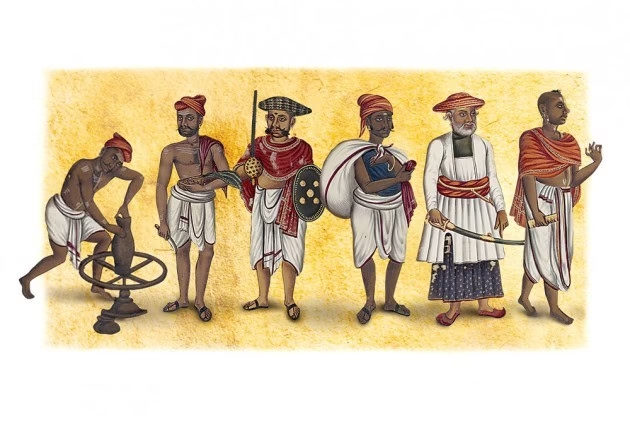Caste in India is real. It’s visible in surnames, marriages, housing, and, in many places, in politics. But the rigid, all-India caste structure we’re told has existed for thousands of years is largely a product of modern colonial administration. What existed earlier was not egalitarian, but it wasn’t immovable either.
Before the British arrived, Indian society was organized through thousands of jatis, localized communities often shaped by trade, region, and political patronage. These social arrangements weren’t uniform, and they weren’t fixed. Groups could rise through land ownership, military service, or aligning with local power. In many cases, peasant communities became locally dominant, and occupational shifts were possible. Sanskritization, where a group adopted the customs of a higher caste, was one of many ways mobility occurred. Even the varna framework was more notional than operational. What changed under British rule wasn’t just scale, but structure.
The British arrived with the administrative impulse of categorization. They mistook Hindu scripture for legal code. They treated the Manusmriti as representative of society, ignoring that India had always lived beyond its texts. With the first systematic census in 1871, the British codified caste identities across the subcontinent. Communities were sorted into artificial hierarchies based on four varnas, even though many didn’t fitnor rejected the categories altogether.
Colonial governance then tied caste to the economy. Access to land, taxation, policing, and even military recruitment began to hinge on caste identity. The Criminal Tribes Act and the Martial Races theory institutionalized stereotypes. In the name of efficient rule, the British created a framework that made caste legally and economically inescapable.
This system endured even after the British left.
Post-independence, the framers of the Indian Constitution sought to undo this damage. B. R. Ambedkar, one of the Constitution’s principal authors, helped build a legal framework aimed at dismantling caste-based discrimination. Articles 15 and 17 outlawed exclusion and untouchability. Reservation policies provided access to education, government jobs, and political representation for Scheduled Castes and Tribes. The SC/ST (Prevention of Atrocities) Act added teeth to those protections. Over time, legal reform began shifting what had long been considered destiny.
The politics of caste also began to evolve. In the 1970s and 1980s, the Janata Dal and its regional successors championed the cause of the Other Backward Classes (OBCs), culminating in the implementation of the Mandal Commission. That policy, despite controversy, opened institutional doors for millions who had been shut out. But many of these parties eventually hardened into caste-based, dynastic organizations. In some cases, they ended up preserving caste identity for electoral math rather than reducing its hold on society.
Alongside them, a different approach emerged.
The Rashtriya Swayamsevak Sangh (RSS) and the Bharatiya Janata Party (BJP) have historically emphasized unity over fragmentation. Through grassroots outreach in tribal and Dalit communities, inter-caste meals, and education programs, the RSS has sought to integrate marginalized groups into a broader Hindu identity. Critics have questioned this for avoiding the deeper question of structural inequity. Yet on the ground, it has often worked to blur caste boundaries where previous actors reinforced them.
The BJP, particularly under Prime Minister Narendra Modi, India’s first OBC Prime Minister, has promoted a wider, pan-Hindu coalition. Non-dominant castes have risen to positions of political prominence in state and national roles. Policies like the 10% economic reservation for the economically weaker sections, regardless of caste, reflected a shift from identity-based entitlements to poverty-based empowerment. Government initiatives such as Mudra loans, Stand-Up India, and Jan Dhan bank accounts have aimed at economic mobility without caste labels.
This doesn’t mean caste is gone. It still shapes local elections, social habits, and marriage decisions—especially in rural areas. But caste’s grip on occupation, education, and power has weakened. Economic liberalization, urban migration, digital access, and educational expansion have loosened old ties. Merit has started to challenge lineage. Among younger generations, particularly in cities, caste is more of a curiosity than a compass.
Still, discrimination persists, sometimes brutally. A casteless society isn’t here yet. But India is moving in that direction.
Understanding caste today means understanding how it was locked into place, not by tradition alone, but by colonial bureaucracy. It also means recognizing the post-independence effort to break that lock: through the Constitution, through political mobilization, and through cultural integration.
The next step requires more than laws. It demands equal opportunity, visible inclusion, and social mobility that reaches every district, not just metros. It asks political parties to treat caste as a challenge to be solved, not a constituency to be managed.
Caste may never fully vanish. But its power to define someone’s entire life is diminishing. And in a country as large and layered as India, that’s not just progress, it’s transformation.


Leave a Reply